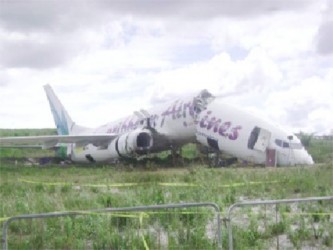With pilot error and poor cockpit coordination being found as major contributors to the Caribbean Air-lines Limited (CAL) flight that overshot the runway at the Cheddi Jagan Inter-national Airport, Timehri (CJIA) in 2011, the airline has been advised to conduct training for its flight crews to ensure they operate according to protocol.
Announcing the findings in the Guyana Civil Avia-tion Authority (GCAA) accident report of the June 30, 2011 crash landing of BW 523 at a news conference on Friday, Public Works Minister Robeson Benn said the Boeing 737-800 aircraft touched down approximately 4,700 feet beyond the runway threshold, “as a result of the Captain maintaining excess power during the flare, and upon touching down, failure to utilise the aircraft’s full deceleration capability resulted in the aircraft overrunning the remaining runway and fracturing the fuselage.”
Benn also said that the “flight crew’s indecision as to the execution of a go-around, failure to execute a go-around after the aircraft floated some distance down the runway and their diminished situational awareness contributed to the accident.”

It was noted that the crew did not command maximum brake pressure until the aircraft was 250ft from the end of the runway or 450ft from the end of the paved area. “The vehicle performance study shows that under the event conditions, the aircraft could have been brought to a safe stop on the remaining pavement if the maximum braking pressure had been applied,” he added.
The investigations revealed that during the landing, there was not significant interaction between the pilot and the first officer. Lead investigator Paula McAdam, of the GCAA, said, “…It showed to us that there was a lack of awareness in the cockpit of where the aircraft was, so we came to the conclusion that there was not effective coordination. It is in fact called cockpit resource management and it was lacking in this case.”
She singled out communication and coordination between the pilot and co-pilot in the cockpit. They both have responsibilities, she mentioned, but both parties were found lacking.
McAdam added that what came out of the investigation, was that the suddenness of the whole incident prevented the cockpit crew from giving warning to the cabin crew because of damage to the aircraft that also damaged the communications equipment in the cockpit.
The aircraft had no mechanical defects that would have contributed to the accident and the wet surface of the runway did not inhibit its braking capacity, the investigation also found.
The Accident Investigation Team, headed by McAdam, comprised representatives from the Trinidad and Tobago Civil Aviation Authority (TTCAA), CAL, the United States of America’s National Transportation Safety Board (NTSB), the Boeing Company and the Caribbean Aviation Safety and Security Oversight (CASSOS).
As a result of the findings of the probe, recommendations were directed at CAL, the TTCAA and the CJIA, McAdams announced.
The recommendations to CAL are focused on training, including training for flight crew to ensure that they conform with and operate within Standard Operating Procedures.
McAdam said also recommended is training in the various techniques detailed in the Boeing Operations Manual, training in crew resource management and especially the roles of the crew and the importance of decision making, training for flight crews in the use of the blow out panels to facilitate quick escapes and training for cabin crews to enable them to develop the correct procedures that are pertinent to operating the exits when aircraft are in an unusual altitude.
In addition, the TTCAA was advised to carry out a full review of the CAL flight and crew training programme to ensure that it is in keeping with the Boeing programme, review the cabin crew training to ensure it is in keeping with the requirements of the training manual and review CAL’s record keeping to ensure documents are properly completed and signed off.
For the CJIA, McAdams said it is recommended that in the planned runway extension, the development of Runway End Safety Areas in keeping with International Civil Aviation Organisation standards.
She said it is also recommended that the airport must provide an easily identifiable area that is set aside to provide comfort to passengers in distress and their relatives during an emergency. She added that the airport must arrange for an engineering assessment of the runway slope and provide notification for its publication in the Guyana Aeronautical Information Publication. In addition, she said it was also recommended that the airport investigate and determine why there was no reaction from its security service and implement training exercises to familiarise them with their responsibility in keeping with the Airport Emergency Manual.
McAdam noted that the Guyana Rescue and Firefighting unit based at CJIA were the first responders and went into action in keeping with the Airport Emergency Manual. The fire vehicles, she said, responded promptly and firemen entered the aircraft and assisted with passengers and crew evacuation. “Despite the cabin crew not receiving the emergency evacuation call from the cockpit, they realised that something was amiss and directed their efforts towards the safe evacuation of the passenger,” she stated.
Additionally she said that CAL ground staff entered the aircraft and took precautionary action to prevent the possibility of explosion or fire. A contingent from the Guyana Defence Force base at Timehri also responded and effectively cordoned off the wreckage and were later assisted by the Guyana Police Force.
Meanwhile GCCA attorney Amanda Desir, who read a preliminary statement, said that GCCA wanted reiterate the fact that “these reports are prepared pursuant to Article 26 of the Chicago Convention and we would like to stress the fact that the sole objective of these investigations, are for the prevention of accidents and incidents. And it is not the purpose of these investigations to apportion blame or liability, so that whatever it said here today, it must be taken in that context.”
There were no fatalities among the 163 people aboard the flight, which included six crew members. However, several passengers were injured, including one man, Noel Elliot, who later had to have one of his legs amputated as a result of the injuries he sustained.
Since the crash landing, several passengers have the sued CAL, which has settled some of the claims.




